
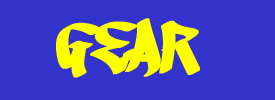


 |
|||||
 |
 |
 | |||
 |
 |
| Blocking is the hardest, yet most important job of the catcher. Past balls not only advance runners, but ruin the tempo of the game and will take away any confidence your pitcher has in you. Here are some things to remember:
1. When you hit the dirt, throw your legs backwards so your chest came come forward. This will create and angle to knock the ball straight down and not bounce away from you. Look at the picture below. 2. Always turn your glove over and keep it over the "5 hole." You don't want to try and catch the ball with your glove, since most of the time you will miss. Just let the ball hit your body. You will get more bruises this way, but it is more effective. 3. Make your throwing hand into a fist, and place it behind the glove when you are blocking. It will prevent injuries to your hand. 4. Block the ball towards the plate. When it is off the plate, slide out around the ball and block it towards the plate so it will fall in front of you. 5. The best way to get batter at this is to just have someone throw rapid fire at you. Your body will create a muscle memory, and you will block everything. |
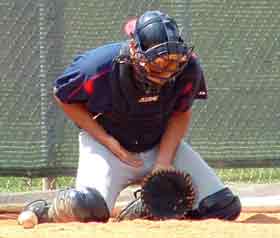 |
 |
| Framing is the a quick way to be your pitchers best friend. Pitchers have a hard enough time throwing strikes, and stealing a few will make their job much easier. It is pretty simple, just remeber these key points:
1. Always catch the ball towards the plate. If the pitch is outside, turn the glove towards the plate. This makes the ball look two inches closer to the plate, and an ump will give you the call every time. 2. Catch the ball out in front. This provides less distance for the ball to move, and shows the ump that the ball is right on the plate. On high pitches, you should catch the ball closer to your body, to allow the ball to sink lower into the strike zone. 3. Don't move the glove back over the plate. Umps will not give you the call then, and will remember and not give you the call later. |
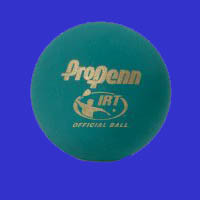 |
Raquetball Drill All you need for this drill is a raquetball. You can either have someone throw it to you, or just bounce it off a wall. As you catch it, just try to frame the ball where it is pitched. The ball is very bouncy, so you need soft hands to catch it. After a while, you will be catching everthing the pitcher throws. |
 |
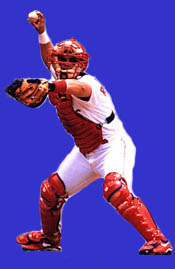 |
A catchers throws must be quick and fast. You don't have time to windup and throw like other positions. The balll needs to be out as soon as you get it so you can get runners out. Here are some steps to give you that quick throw: 1. After you catch the ball, bring it straight back to your ear. This cuts down the time it takes to bring the ball all the way down like a pitcher or an outfielder. Look at the picture of Ivan Rodriguez above. 2. If a runner is stealing second, you should be moving forward before the ball gets to you. This will provide momentum to get the ball to second quicker. 3. If a runner is stealing third with a right-handed batter, you will need to step away from the batter to make the throw. On an inside pitch, step behind the batter. On an outside pitch, step in front of the batter. This will give you the clear lane to throw. If the batter gets in the way, run into him and get an interferance call. 4. On double plays, you should keep your back leg on the back of the plate. When you catch the ball, slide out like a middle infielder and make the throw to first. You can use a similar slide step when throwing pickoffs to first base. |
Hockey Puck Drill All you need for this drill is a hockey puck. You hold the puck so it is vertical, then take your index and middle finger and place them on the outside of the puck. All you do is use your wrist to throw it up in the air. You want to get it to spin straight. This drill will get you to flick the ball out of your wrist. Football Drill With this drill, you simply just throw a football. This will force you to bring the ball back to your ear. Be careful, throwing a football requires a twist of the wrist not used in baseball. Either don't twist your wrist or be sure to throw a baseball a few time afterwards. |
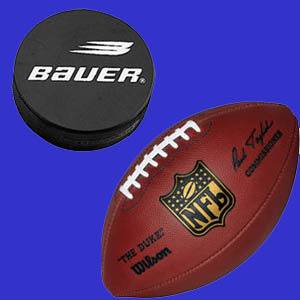 |
 |
In my opinion, a play at the plate is the most exciting play in baseball. It is do or die, and it is one of the few times where the catcher can be the hero. It takes concentration, and the knowledge that you may be run over. These points are key to getting that runner out: 1. Stand with your left foot in front of the top corner of the plate. On a good throw, you will be able to catch the ball, pivot on your left foot, and bring your right leg over in front of the plate. This allows you to cover the plate, and you are not in the runners way if there is no play. 2. If the throw is offline, you may need to move away from the plate. If you are running up the thrid baseline, stay out of the path of the runner. You don't want to get trampled before you even have the ball. 3. If the throw hits the dirt, you just have to watch it into the glove. The pitcher will be backing you up, so you can take the risk. If it doesn't seem like you can get the runner, just knock the ball down and look to get a different runner. |
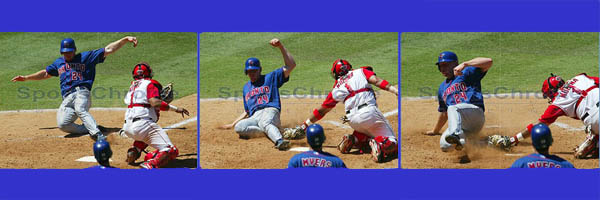 |
 |
Catchers Thumb Catchers thumb is a very common injury. It comes from catching the ball the wrong way, and your thumb will bend back. It becomes more common as pitchers throw faster with more movement, and it can be painful. I have torn ligaments and broken bones in my thumb multiple times. There are ways to prevent it, but it will still happen. You just need to suck it up and play with the pain. |
Taping a Thumb By using this taping method, you can only keep your injuries from being severe. It will not prevent injuries, so don't expect it to fix all your problems. 1. Wrap a piece of peliminary tape around your wrist. 2. Get a piece of white tape about 8 inches long, and tear it in half. 3. Start one piece on the outside of your wrist, wrap it around your thumb, and place back on the inside the wrist. Repeat with other piece. 4. Get another 8 inch piece and rip it in half. Take one peice and repeat the previous steps. 5. Find the middle of the second piece, and place it on the middle of your thumb. Wrap the ends of the tape around the thumb in the opposite direction of the previous peices. 6. Use a piece of white tape to wrap around your wrist. |
 |
|
|